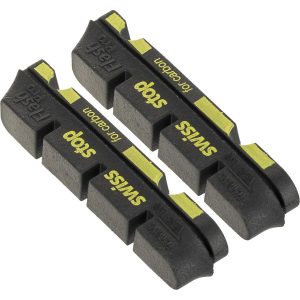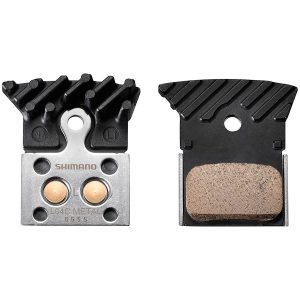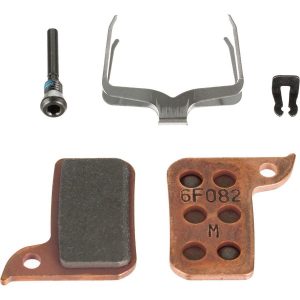The 5 Best Road Bike Brake Pads in 2020
Are you having to pull harder on the brake levers to slow down?
When you do, is there a horrible squealing noise?
It’s time for new brake pads.
But buying new brake pads isn’t as simple as sounds. Certain pads are only compatible with certain brands. To add another layer of complexity, there are different types of brake pad materials to suit different needs and wheel types.
On this page, I’ll guide you through some of the basics you should know about brake pads and suggest some popular models among cyclists.
For Aluminum Rims
SwissStop FlashPro BXP

- Brake Type : Alloy rim
- Compatibility : SRAM, Shimano
The FlashPro BXP pads are designed for use with alloy rims and are compatible with SRAM and Shimano rim brakes.
SwissStop has become one of the premier manufacturers of brake pads in the cycling world, and that’s largely due to the research and development engine of its parent company, Rex Articoli, which specializes in developing rubber compounds for a variety of uses.
About 10 years ago, Rex Articoli went to work to develop a rubber compound that would improve braking power and modulation while preserving durability and minimizing brake squeal.
The result was the Swiss Stop FlashPro BXP, a brake pad that significantly cuts the distance needed to go from 60 to 0 mph while allowing for even braking with no sudden jerks.
- Pros : Excellent bite in both dry and wet conditions.
- Cons : Expect to pay slightly more.
For Carbon Rims
SwissStop FlashPro Black Prince

- Brake Type : Carbon rim
- Compatibility : SRAM, Shimano
SwissStop takes the brake pad technology from its FlashPro BXP brake pads for alloy rims and applies it to a set of pads for carbon rims with its Black Prince pads. These pads use the same rubber compound that provides such great stopping power and feels with the BXPs. There are; however, some differences.
One of the first things you’ll notice about the FlashPro Black Prince brake pads is that they are significantly thicker than alloy BXPs pads. This means greater life for each set of pads. It also means deeper channels for wicking away water for better performance in wet conditions.
- Pros : Widely available at an affordable price.
- Cons : Not available in Campagnolo variants.
Campagnolo Pads

- Brake Type : Carbon rim
- Compatibility : Campagnolo
If you’re looking for high-performance brake pads for carbon rims, this is it. Even though it’s designed to work with Campagnolo rim brakes, there’s a little-known variation of it that works with Shimano/SRAM brake calipers (model : BO500X1).
If you’ve shelled out the money to invest in a set of Campagnolo’s legendary carbon rim wheelsets, then you darn well better make sure you buy brake pads that will protect those beautiful Italian wheels by buying a set of Campagnolo’s carbon brake pads to go with them.
These Campagnolo brake pads are made with a special blend of compounds specifically designed to engage with the 3Diamant and newer AC3 brake tracks on Campagnolo Bora or Hyperon carbon wheelsets.
- Pros : Excellent stopping power in dry conditions when paired with Campagnolo or Fulcrum carbon wheels.
- Cons : Shimano version can be hard to come by.
For Disc Brakes
Shimano RS805 Ice-Tech

- Brake Type : Disc
- Compatibility : Shimano Dura Ace, Ultegra and 105
Shimano’s top of the line disc brake pads, the BR-RS805 brake pads uses the company’s patented Ice Technology and metal composition to provide maximum stopping power.
You can choose from either a metal or resin compound. The real engineering feat with this set of pads is the grooved aluminum and stainless steel fins that dissipate heat because heat causes brake pads to lose their effectiveness and shortens their life span.
This means better both performance and longer brake pad life.
- Pros : Cooling fins allows for efficient heat dissipation during long descends.
- Cons : Resin compound has a shorter lifespan (but more bite).
SRAM HRD Road

- Brake Type : Disc
- Compatibility : SRAM Red/Force AXS
Riding SRAM disc brakes and weighing your options?
Avoid the lure of cheaper generic brake pads and go with SRAM’s top of the line disc brake pads. There are two brake pad material options.
Choose the sintered pads for durability and maximum stopping power on extended downhill rides or in wet conditions, or go with the organic compound pads for better responsiveness and quieter brakes.
These brakes are compatible with SRAM’s hydraulic road disc brakes and its Level Ultimate and TLM mountain bike disc brakes. Optional aluminum plates are included that can be added to the pads to help dissipate heat.
- Pros : Compatible with both SRAM’s road and mountain bike hydraulic disc brake calipers.
- Cons : Expect to pay slightly more.
Rim Brake Pads Buying Guide
This section is for those who’re riding rim brakes, both alloy and carbon wheelsets.
1. Braking Track Materials
The braking track is the flat surface of your wheel’s rim where the brake pad engages the wheel. Rims have two different braking track materials :
- Aluminum alloy
- Carbon
All aluminum alloy wheels will have alloy braking tracks, but not all carbon wheelsets will have carbon brake tracks. There are older carbon wheelsets (usually pre-2016) that have an alloy brake surface.
Why is this so important?
Carbon braking tracks produce significantly more heat during use.
As such, pads designed for carbon brakes are rated up to 320ºC, while brake pads designed for alloy rims are only rated up to 180ºC.
The brake pads need to match the braking track material, otherwise expect to quickly burn through your brake pads or suffer bad braking performance. Even carbon-rated brake pads used on alloy wheelsets don’t offer very good performance due to the difference in compounds.
2. Brake Shoe Type
In addition to being made with a variety of different compounds for different braking track materials, brake shoes also come in different shapes.
With that in mind, make sure to check for compatibility when replacing brake pads.
While SRAM and Shimano have the same brake shoe shape, meaning pads will fit both brands, Campagnolo doesn’t.
You’ll usually come across the option to choose for SRAM/Shimano and Campagnolo especially if you’re buying aftermarket brands such as Swiss Stop.
Make sure to get the right one.
Disc Brake Pads Buying Guide
If your bike is running disc brakes, then read on.
1. Brake Caliper Brand
Road bike disc brake manufacturers such as SRAM, Campagnolo, and Shimano all produce brake calipers with varying shapes.
As such, you need to purchase pads that are compatible with the brand of disc brakes that you have.
The rule of thumb is to stick to the same brand as your disc brakes calipers.
2. Brake Pad Compounds
This can quickly get confusing as there is no standard terminology among brake pad manufacturers, which tend to use different terms to refer to the same material.
That said, brake pads are made of one of three different compounds;
- Sintered
- Semi-metal
- Organic

Sintered / Metal Compound (Hard)
Sintered pads, which are also commonly referred to as metal or metallic, are the most durable of the three options.
This is because metal better withstands high temperatures. They also offer the most power during prolonged use, such as on a long downhill.
They do, however, have their cons. Sintered pads tend to lose power with hydraulic setups over long descents as they tend to transfer heat to the brake fluid. They also aren’t as responsive when first engaged, and because they take longer to bed in, they can be noisy for a while.
Semi Metal Compound (Medium)
The best of both worlds, semi-metal pads are basically organic pads with metal added to them.
They’re more durable than organic pads, provide excellent power for downhill runs, and offer good responsiveness.
That said, even these hybrid pads aren’t perfect. Semi-metal pads can glaze over. They’re also typically more expensive. You also need to be aware that not all semi-metal pads are the same, as each uses a different mix of organic and sintered materials.
Organic Resin Compound (Soft)
If you’ve hydraulic disc brakes and you can’t stand the squealing, then organic pads might be the answer for you.
Organic pads bed in quickly and, as a result, are much less noisy than sintered pads.
That said, they don’t last as long and offer less power on sustained downhills. They are also more likely to glaze over than sintered pads. Glazing occurs when the surface of the pad crystallizes, reducing the braking power and creating noisy brakes.
Read More :
Frequently Asked Questions
1. When should I replace my brake pads?
Check wear to determine whether or not it’s time for a pad change.
Most rim brakes have deep indentations in the pads to help with modulation and to provide channels for water to escape. If these indentations have disappeared or are barely visible, it’s time for new pads.
For disc brakes, you need to remove the pad from the brake calipers and check the wear. New disc brake pads typically have about 4mm of wear. When this gets down to 1mm, it’s time to replace the pad.
2. How do I reduce the squealing noise during braking?
For rim brakes, do a toe-in by altering the angle of how the pad engages with the rim. Adjust the angle, so the front of the pad engages with the rim first, or try a reverse toe-in so that the rear of the pad engages with the wheel first.
For disc brakes, prevention is the best way to avoid squeaky disc brakes, often contaminated with lubricant. Avoid using spray lubricants anywhere near your brakes. If they are contaminated, use a degreaser to clean the rotors and pads.
3. Can I use carbon brake pads on aluminum rims?
It won’t hurt anything, but you also won’t get the best performance by using carbon brake pads on alloy rims. This is for the simple reason that the brake pad compound is designed to engage with carbon, not aluminum alloy.
But absolutely do not use alloy brake pads for rims with carbon brake tracks. Why?
Brake pads designed for alloy rims are not designed to handle the heat created by carbon brake tracks. They will quickly shred, potentially causing brake failure. They may also do permanent damage to your expensive carbon wheels.
Author Recommended Reads
